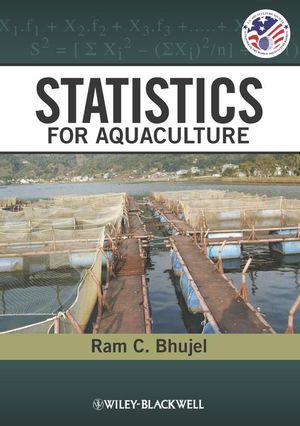Statistics for AquacultureISBN: 978-0-8138-1587-9
Hardcover
240 pages
March 2009, Wiley-Blackwell
 This is a Print-on-Demand title. It will be printed specifically to fill your order. Please allow an additional 15-20 days delivery time. The book is not returnable.
|
||||||
Preface xi
The Society Preface xiii
Acknowledgments xv
1 Introduction 1
1.1 Background 1
1.2 History and definition of statistics 3
1.3 Scope and application 5
1.3.1 In general 5
1.3.2 In aquaculture 6
1.4 Questions 7
1.5 Practical exercise 7
2 Experimental units in aquaculture 9
2.1 Background 9
2.2 Earth ponds 9
2.3 Hapas and cages in ponds 10
2.4 Cages in lakes or reservoirs 12
2.5 Tanks 12
2.6 Aquaria 12
2.7 Farmer’s field: participatory research 14
2.8 Conclusion 16
2.9 Questions 17
2.10 Practical exercises 17
3 Sampling and data collection 19
3.1 Sampling principles and methods 19
3.2 Parameters or variables 20
3.2.1 Variable types 21
3.2.2 Variables of aquaculture 21
3.3 Fish sampling 24
3.4 Sampling of feed and feed ingredients 24
3.5 Water sampling and monitoring 25
3.6 Sampling of eggs, muscles, blood, and others 26
3.7 Sample size (volume/number) 27
3.7.1 Simple method for sample size estimation 28
3.7.2 Comprehensive method for sample size estimation 29
3.7.3 Sample size estimation for survey research 30
3.8 Questions 31
3.9 Practical exercises 31
4 Data accuracy and exploratory analysis 33
4.1 Importance 33
4.2 Data accuracy and precision 33
4.3 Significant numbers 34
4.4 Errors and their sources 35
4.4.1 Gross errors 35
4.4.2 Systematic errors 36
4.4.3 Random or residual errors (unsystematic) 36
4.5 Error minimization and separation 36
4.5.1 Experimental conditions and procedures 36
4.5.2 Materials, methods, and equipment 36
4.5.3 Randomization 37
4.5.4 Pairing 38
4.5.5 Blocking 38
4.5.6 Measurement of additional variables/factors 38
4.5.7 Increasing number of treatments and replication 38
4.6 Exploratory data analysis 39
4.6.1 Checking for any errors 40
4.6.2 Comparison with others 40
4.6.3 Useful tools 40
4.6.4 Basic assumptions 41
4.7 Normal distribution 42
4.7.1 Concept of probability 43
4.7.2 Frequency distribution and probability 44
4.7.3 Grouping classes 46
4.7.4 Histogram and frequency curves 46
4.7.5 Variance heterogeneity 47
4.7.6 Data transformation 49
4.8 Questions 51
4.9 Practical exercises 51
5 Central locations and variability 55
5.1 Concept and importance 55
5.2 Measure of central tendency 56
5.2.1 Mean 56
5.2.2 Median 58
5.2.3 Mode 60
5.2.4 Midrange and midhinge 62
5.2.5 Quartiles, percentiles, and others 63
5.3 Measure of variability 64
5.3.1 Range 64
5.3.2 Interquartile range or quartile deviation 65
5.3.3 Mean deviation 65
5.3.4 Variance and standard deviation 65
5.3.5 Population and sample variance/SD 66
5.3.6 Standard error 67
5.3.7 Coefficient of variation 68
5.3.8 Implications of variability 68
5.4 Questions 69
5.5 Practical exercises 70
6 Basics of hypothesis formulation and testing 73
6.1 Concept 73
6.2 Significance level 74
6.3 Confidence level, limits, and interval 74
6.4 Statistical and biological significance 75
6.5 Errors in hypothesis testing 76
6.6 Selection of statistical tools 77
6.7 Test of goodness-of-fit 78
6.7.1 x 2-test 79
6.7.2 One-sample K–S test 82
6.8 One- and two-sample tests 82
6.8.1 Parametric tests: t- and Z-tests 84
6.8.2 Nonparametric tests: Mann-Whitney and Wilcoxon’s tests 92
6.9 Questions 96
6.10 Practical exercises 96
7 Experimental designs and analysis of variance 99
7.1 Background 99
7.2 Completely randomized design 99
7.2.1 Parametric test 101
7.2.2 Nonparametric test: Kruskal-Wallis test (H-test) 105
7.3 Randomized complete block design 108
7.3.1 Parametric test using ANOVA 109
7.3.2 Nonparametric test: Friedman test for RCBD 112
7.4 Latin square design 115
7.5 Factorial experiments 122
7.6 Questions 131
7.7 Practical exercises 131
8 Testing and exploring relationships 135
8.1 Background 135
8.2 Single-factor regression 136
8.2.1 Simple linear regression 136
8.2.2 Hypothesis testing 140
8.2.3 Nonlinear regression 142
8.2.4 Model formulation and selection 144
8.3 Multiple regression 148
8.3.1 Methods 148
8.3.2 Example 149
8.3.3 Interpretation of results 151
8.3.4 Prediction 152
8.3.5 Selection of method 153
8.4 Correlation and parametric test 153
8.5 Nonparametric tests for regression and correlation 156
8.5.1 Spearman’s rank correlation 156
8.5.2 Kendall’s rank correlation or Kendall’s coefficient of concordance 157
8.6 Multiple correlations 159
8.7 Questions 161
8.8 Practical exercises 161
9 Advanced topics 163
9.1 Cluster analysis 163
9.1.1 Univariate cluster analysis 163
9.1.2 Multivariate cluster analysis 167
9.2 Analysis of Covariance 168
9.3 Multivariate ANOVA 173
9.4 Interpretation of results 176
9.5 Questions 179
9.6 Practical exercises 179
Appendix A 181
Appendix B 193
Bibliography 215
Webliography 217
Index 219



